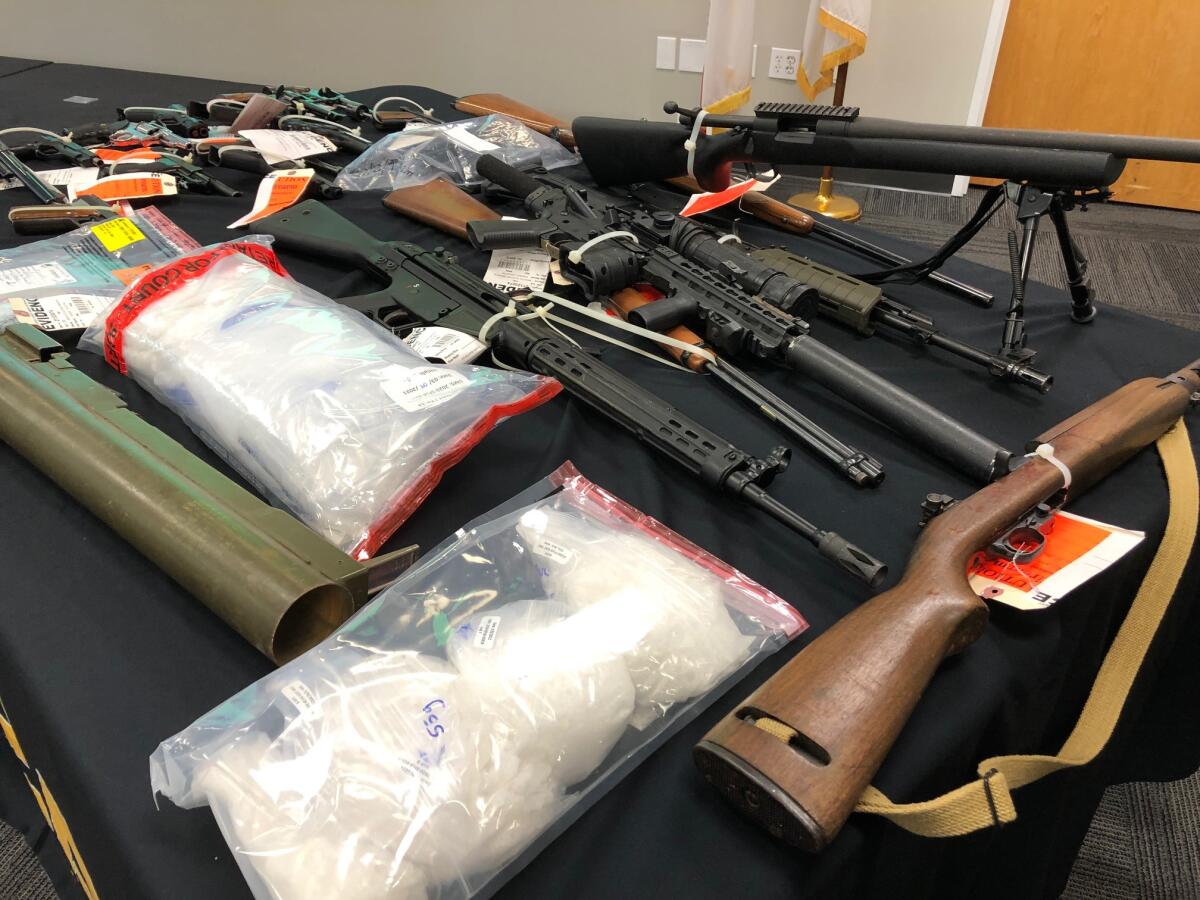San Diego meth trafficker who hid out in rural Minnesota sentenced to 14 years in prison

- Share via
SAN DIEGO — In the early days of the COVID-19 pandemic, one man “dominated” the San Diego methamphetamine market as border restrictions hampered smuggling routes and the price of the drug “skyrocketed,” a federal prosecutor said Monday.
Reyes Espinoza, who lived with his family in San Ysidro but also split time between Mexico and a rural hideout in northern Minnesota, was coordinating the cross-border movement of 40 to 100 pounds of meth each week during much of 2020 and the first part of 2021, Assistant U.S. Attorney Matthew Sutton told a judge in San Diego federal court.
Sutton estimated that Espinoza, the lead defendant in a 60-person federal indictment filed last year, was making a profit of $2,000 to $3,000 per pound of meth — or roughly $80,000 to $300,000 in earnings per week.
“He was getting good money from this crime,” Sutton said.
U.S. District Judge Marilyn Huff on Monday sentenced Espinoza, 37, to 14 years in federal prison on meth trafficking and money laundering conspiracy charges. Huff said Espinoza was a “high-level source of supply” for a meth trafficking network that prosecutors alleged had ties to Mexico’s Sinaloa cartel.
Reyes Espinoza pleaded guilty to meth-trafficking and money-laundering conspiracies but did so without a typical plea agreement
Huff rejected the prosecution’s request for a prison term of more than 17 years, indicating that would be too harsh a sentence.
“I don’t think he’s an ‘El Chapo’ Guzmán,” the judge said, referring to the notorious former leader of the Sinaloa cartel who is now serving a life sentence in federal prison.
But the judge said the 10-year sentence recommended by defense attorney Marcel Stewart was “too little” considering the amount of meth Espinoza was moving and the drug’s “really long-term effects.”
An extensive wiretap investigation that began in the spring of 2020, dubbed Operation Crystal Hydra, uncovered the network that Espinoza supplied, according to prosecutors. The investigation began based on information from a confidential informant who identified John Bomenka, a San Diego man in his 50s, as a major meth dealer.
The investigation expanded from there, with the discovery that Bomenka’s principal drug source was David Villegas, a man in his late 40s who was living in a motorhome at Mission Bay RV Resort.
Bomenka has pleaded not guilty to the charges against him and remains in custody awaiting trial. Villegas pleaded guilty in September 2021 to meth trafficking and money laundering conspiracies and remains in custody awaiting sentencing.
Investigators identified San Diegans as principal sources of meth being sold across the country, according to court records
During the investigation, agents learned Espinoza was the one supplying Villegas. Prosecutors alleged he was also the conduit to the Sinaloa cartel, which for years has supplied U.S. markets with cheap, high-quality meth made in “superlabs” south of the border.
Sutton argued during Monday’s hearing that Espinoza was rising in the ranks because of his ability to both get meth across the border and to get into the hands of those who could distribute it.
From Espinoza, the meth would go mostly to Villegas but also to smaller scale distributors, with prosecutors saying his supply eventually ended up in Arizona, Iowa, Hawaii, Kansas, Massachusetts, Michigan, Minnesota, New Jersey and Texas, as well as Australia and New Zealand.
In court, Espinoza’s defense attorney argued Villegas was the real leader of the network, not Espinoza. The judge indicated she believed they were both leaders — Espinoza on the supply side and Villegas on the distribution side.
Stewart, the defense attorney, also argued there was no evidence to support the prosecutor’s claim that Espinoza “dominated” the meth market during the pandemic. Huff agreed in part, saying it was not factual to argue Espinoza “had a lock” at that time on the meth coming across the border.
Sutton conceded that large quantities of the drug were still moving through San Diego to the rest of the country, but argued Espinoza was the main source of meth for dealers in San Diego County.
That “amount of meth has a devastating impact” on the community, Sutton said.
The prosecutor argued that while Espinoza and his family lived modestly in a San Ysidro apartment, he lived “quite lavishly” in Mexico. And Sutton said Espinoza’s Minnesota property — purchased with about $200,000 in drug proceeds and now being forfeited to the government — was the “tip of the iceberg” as far as his wealth.
Sutton said authorities believe Espinoza and his wife purchased the home and its 23-acre plot in Remer — population 400 — as “refuge” from the drug trade, though he sometimes managed his trafficking operation from there and hid out there when he suspected, correctly, that Villegas was under investigation.
Stewart argued the Minnesota property was his client’s exit strategy. “He wanted out of this life,” the defense attorney contended.
Federal authorities arrested Espinoza in May 2021 at the San Diego airport as he stepped off a flight from Minnesota. Among the 60 defendants named in the indictment unsealed a few weeks later were Espinoza’s brother, cousin and now-soon-to-be-ex-wife, who was given a short sentence for her role in the conspiracy, and then deported.
Dozens of the defendants in the case have been sentenced and dozens more are still awaiting trials. Others remain fugitives, including Espinoza’s brother and a man identified only as “Sheriff” and described as Espinoza’s right-hand man in Mexico.
More to Read
Sign up for Essential California
The most important California stories and recommendations in your inbox every morning.
You may occasionally receive promotional content from the Los Angeles Times.
















